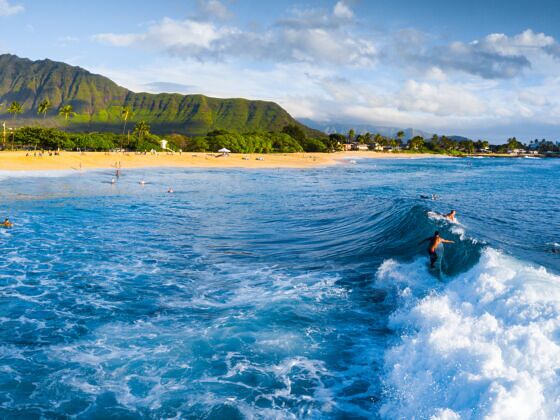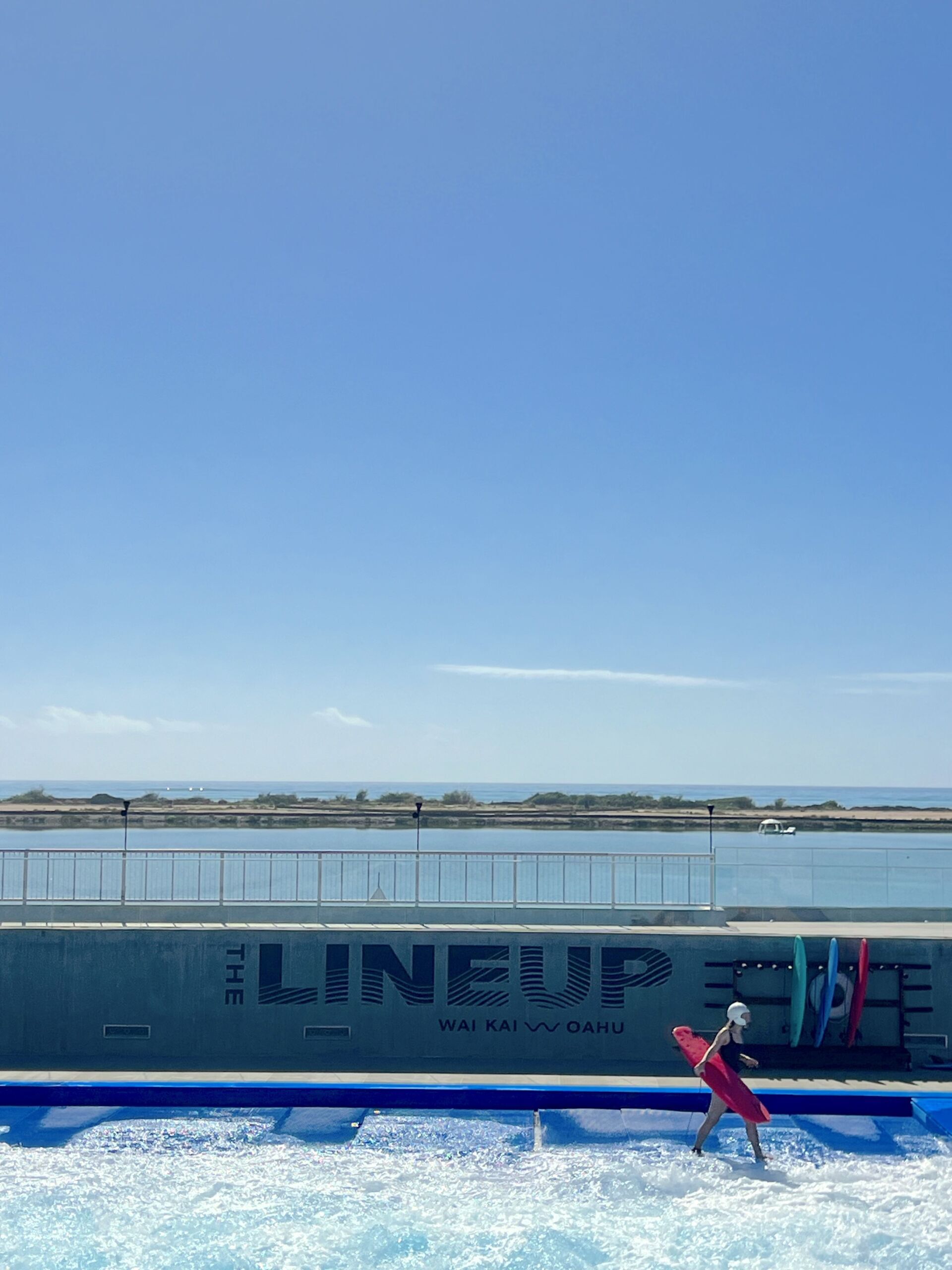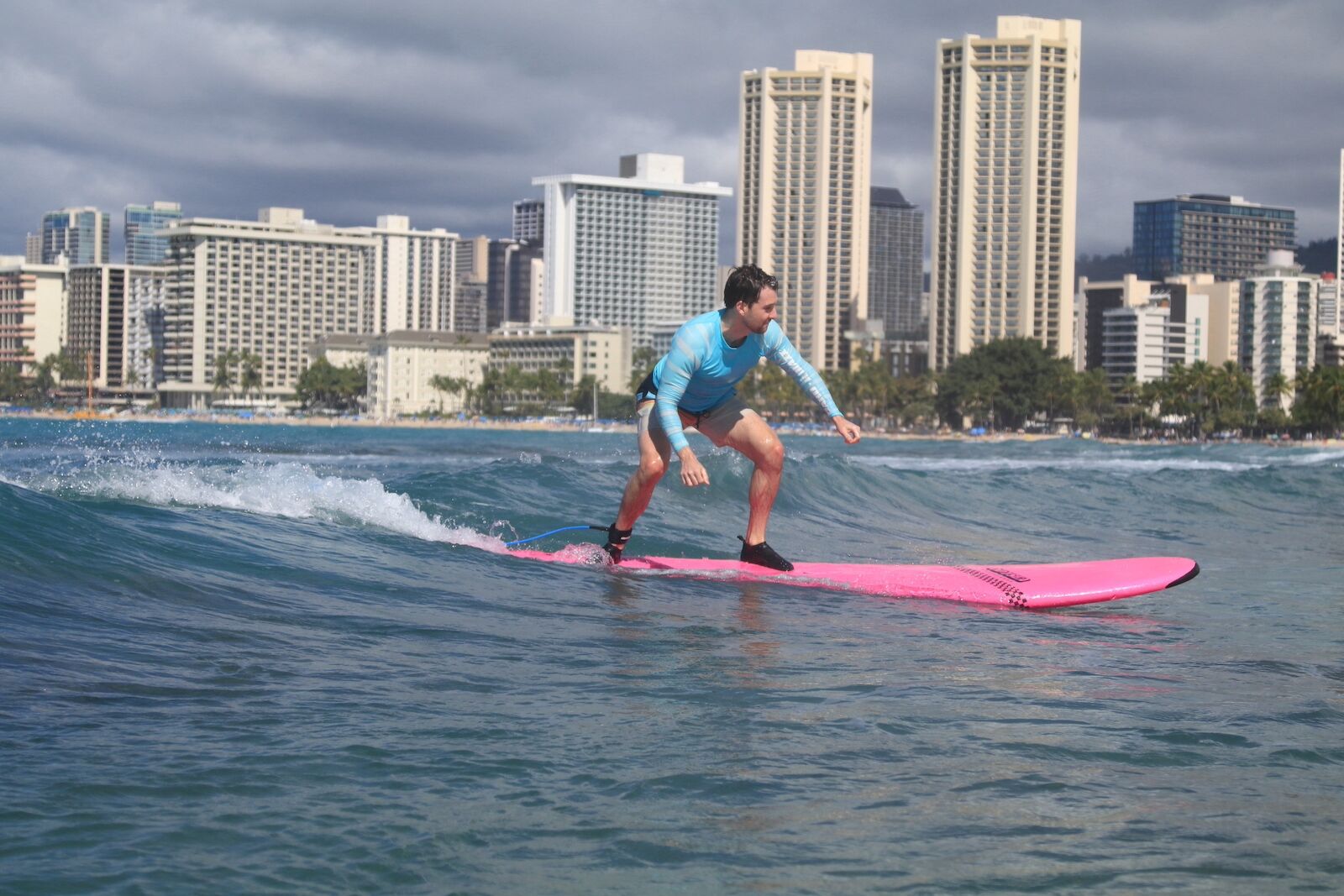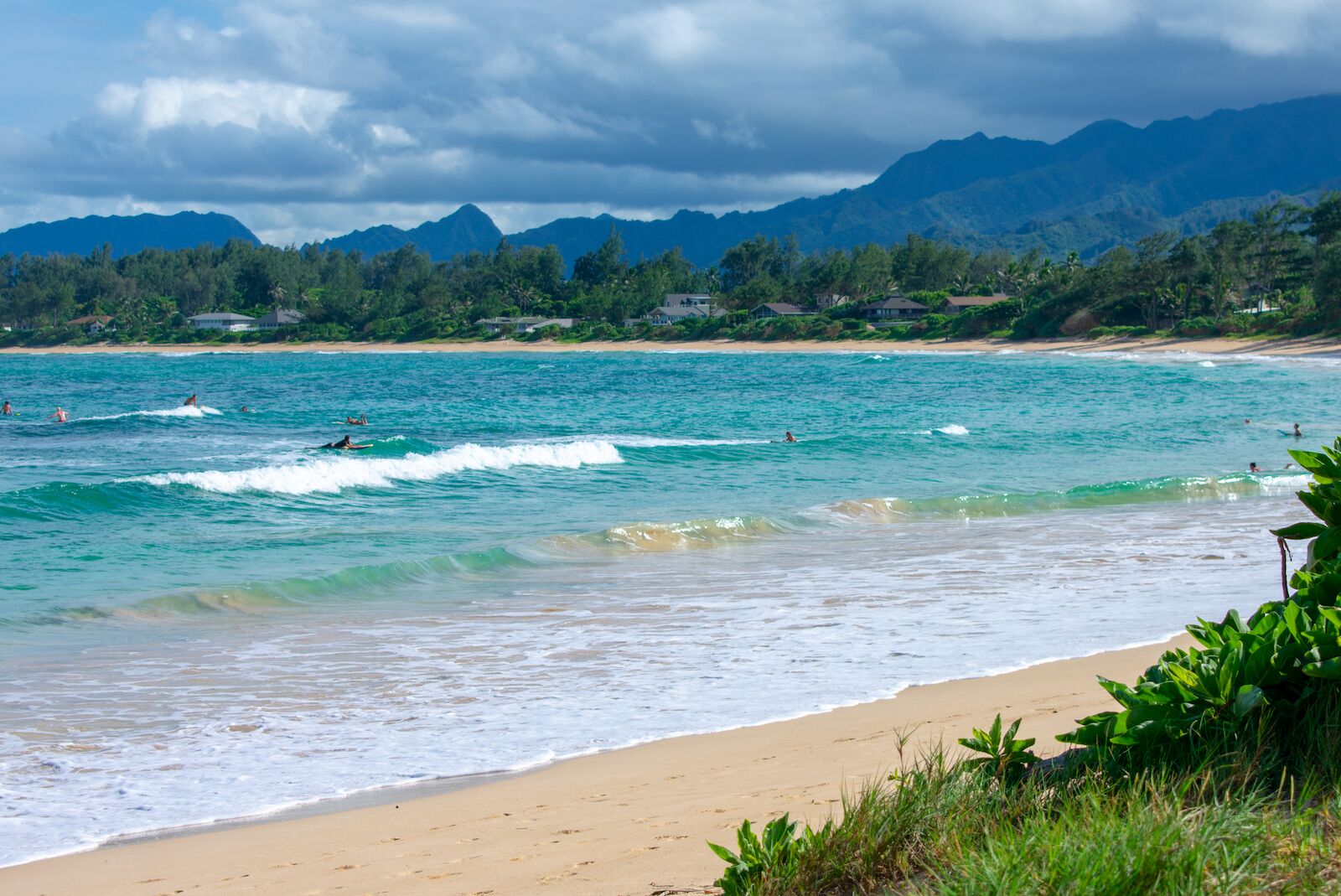A guide to surfing anywhere might as well start in O’ahu. Driving from the South Shore to the North Shore of the third largest Hawaiian island is like drawing a line between the world’s most surfable waters and its most formidable waves. Where professional surfers obliterate records at the Banzai Pipeline reef break in northerly Pupukea, beginners dip their toes, quite literally, into the gentle surf spots off of southerly Waikīkī Beach.

Waikīkī Beach is a highly trafficked area of O’ahu located about 20 minutes south of Honolulu. (Honolulu conveniently hosts Hawai’i’s largest airport.) The area’s considerable development may be off-putting to certain travelers, but for beginner surfers, it spells good news. Not only does Waikīkī Beach have some of the best beginner surf spots on O’ahu, but many of the businesses lining oceanfront Kalākaua Avenue are also there to help facilitate a hassle-free surfing experience, from water sports rental shops like Beach Candy to the Jamie O’Brien School of Surf that operates out of the same storefront.
I recently spent four days in O’ahu learning to surf. I’d surfed before, years ago, but not frequently or competently enough to call myself a surfer. Over the course of four days, based on and near Waikīkī Beach with a couple of day trips to the island’s west and north shores, three specific experiences inched me closer to claiming that title.
Step one:
Book a session at The LineUp at Wai Kai

Photo: Alex Bresler
The main problem I encountered during previous attempts to surf was that no matter how successfully I learned to paddle out, pop up, and balance on a surfboard, I never mastered the art of catching a wave. When I learned that the world’s largest deep-water standing wave recently opened on O’ahu, I jumped at the chance to try surfing on a guaranteed wave.
The LineUp is a surf park that’s part of the greater Wai Kai recreation venue at Ewa Beach, which is about a 40-minute drive west of Waikīkī Beach. I expected a surf park to resemble a waterpark, but what I saw on arrival reminded me more of a country club. There are two restaurants on site, a changing room area that feels more like the relaxation room of a spa than the bathroom of a public pool, and a 52-acre lagoon where visitors can participate in watersports other than surfing or simply lounge in an “aquabana,” or floating cabana.
The biggest difference between The LineUp and a country club is that The LineUp’s 100-foot-long pool is powered by Citywave technology to produce a continuous artificial wave.
What time the wave is turned on varies. Visitors can book sessions on a 30-foot, 65-foot, or 100-foot wave depending on the time and day. The adjustable wave pool can be split into one small and one mid-sized section, perfect for beginners, or span the full 100 feet.

Photo: Alex Bresler
My partner and I were the first ones on the wave the morning we arrived. The LineUp arranged a private session for us with the park’s director of surf operations, Ikaika Kaulukukui. After a brief safety video, Kaulukukui helped me position my soft surfboard near the foot of the wave, taught me how to slide onto it from a seated position on the pool’s edge, and coached me on how to surf the wave: weight on my back foot, knees bent without leaning forward or backward, toes curled to catch an edge when it was time to propel the board forward.
I stayed upright longer than expected for my first time on a standing wave, but beginners should expect to fall often. Even experts invariably end up in the water. The process moves quickly: Surfers line up on the sides of the pool, take turns riding the wave, and exit from the back of the pool once they’ve landed in the water. It’s similar to the ramp etiquette at a skatepark.
After several turns each on the 30-foot wave, my partner and I crossed to the other side of the pool to ride the reciprocal 65-foot wave. Other than length, a slightly more aggressive entrypoint was the only significant difference between the two waves. Once you’re able to balance, the 65-foot wave creates more space to practice your technique and turns.

Photo: Alex Bresler
It’s important to note that the techniques you learn at The LineUp are not perfectly transferable to beach surfing. Kaulukukui likens the wave at The LineUp to a ski slope, where skiers and snowboarders move across a static surface, rather than an ocean wave, where the energy of the water pushes surfers forward from behind.
“In the ocean, your approach is going to be different, but everything from how your weight is transferred, to what the board is doing, to where you’re looking is all going to be the same on this wave as in the ocean,” he explained to me after our session.
This is a particular boon for experienced surfers who want to practice specific moves multiple times in a row. It also benefits beginners. Unlike a traditional surf lesson, a continuous wave allows new surfers to get comfortable on a board without tiring themselves out paddling.
“Here, you get 15 seconds, 45 seconds on the wave and then you fall, so in that 45-minute [session] you probably get triple the amount of time you’d get in a two-hour surf lesson,” Kaulukukui says. “So I’d almost recommend coming and doing something like this first so you can get your body mechanics down.”
Step two: Do a lesson with the Jamie O’Brien School of Surf

Photo: JOB School of Surf
Jamie O’Brien is a professional surfer with several awards and three surf schools to his name. Two of those schools are located on O’ahu: one at the North Shore’s Turtle Bay Resort and a newer school on the main waterfront drag at Waikīkī Beach.
The Jamie O’Brien School of Surf at Waikīkī Beach is located around the corner from the entrance to The Twin Fin hotel. It partners with the hotel and the on-site Beach Candy rental shop to provide beginner surfers with personalized lessons. Mine was led by Jamie O’Brien. While lessons are typically led by one of the shop’s eight instructors, O’Brien tries to make himself available to fans whenever possible, whether that means stopping for photographs when he’s at the shop or hopping on the occasional FaceTime call.
Lessons typically begin with a 15-minute land course that guides guests through body position, paddling technique, and popping up on the board. O’Brien fast-tracked our introduction to give my partner and me as much time in the water as possible. We walked with our soft longboards from the shop toward the Waikīkī Wall, ran through the process once, and paddled out.

Photo: JOB School of Surf
Our lesson continued in the water. We paddled toward a break that yielded a mix of unbroken and whitewash waves, which are a particular boon for beginner surfers as they provide more time and force to catch the wave, away from sections of particularly shallow reef. O’Brien taught us how to fall flatly to avoid harming both ourselves and the coral below. I’d hoped to learn about the art of choosing a wave and the science of when to paddle, but there was little time to talk between attempts: Every time a viable wave approached, O’Brien gave us a push to ensure that we had ample chances to try standing up in favor of more theoretical instruction.
My lesson with O’Brien lasted roughly an hour though he assured me that we could continue until my arms got tired. (This happens quickly for beginners, even with assistance.) Unlike my previous surf attempts, and despite Kaulukukui’s assessment from the day before, the session resulted in a surprising amount of actual surfing, perfect form notwithstanding.
Though I left the Jamie O’Brien School of Surf with more questions about technique than I’d arrived with, I appreciated the emphasis on experience. For first-time surfers, having a helping hand push you across the proverbial finish line is uniquely motivating — without knowing what it feels like to ride a wave, it’s hard to understand why the effort of catching them is worth it.
Step three: Venture beyond Waikīkī Beach

Photo: Alex Bresler
On our last day on the island, we decided to try surfing independently. We rented a car and drove to the island’s North Shore, an area famous for challenging surf that also has a few beginner surf spots. Our plan was loose when we pulled off the Kamehameha Highway near Hale’iwa for lunch at a food-truck park. The North Shore Surf Shop coincidentally operated out of the same lot. We decided to ask a man there where we could surf that afternoon.
That man was Takuyaki Wakita, a professional surfer and team rider for the shop. He gave two options: Halei’wa Beach Park, where many surf schools operate, and Malaekahana Beach, which has no lifeguards but was likely to be less crowded. We rented long foamies, a type of soft and durable surfboard that novices often use, and routed our GPS to Malaekahana Beach.

Photo: Mikela Bond/Shutterstock
There were dozens of surfers at the beach when we arrived. Everyone was clustered around the same break, some close to shore, others deeper into the water. We paddled toward the middle of the pack and observed the surfers who looked slightly more experienced than us. After a few failed attempts to catch a wave, I asked one, a teen girl, what she looked for in a viable wave. “Timing mostly,” she said vaguely. “Whitewash can help.”
In about an hour, I successfully surfed three waves. I chased after countless others. The tips I’d picked up at The LineUp and the Jamie O’Brien School of Surf helped, but the real benefit of all three experiences was exposure to the sport. At The LineUp, I learned that falling can be fun if it means trying again. During my surf lesson, I realized that, like most sports, surfing is one that’s worth the effort it takes. And at Malaekahana Beach, I discovered that even time spent laying on the board, trying to get the hang of things and connecting with other surfers, still means getting to spend an enjoyable afternoon in the water.
Where to stay on Waikīkī Beach:
The Twin Fin

Photo: Alex Bresler
The Twin Fin could reasonably be described as a surf hotel. The name is a reference to split-finned surfboards, a few hand-painted versions of which decorate walls around the hotel. A mural of screens hanging in the lobby plays live Surfline feeds of Waikīkī Beach swells across the street. Beach Candy and the Jamie O’Brien School of Surf operate on the ground floor of the hotel complex, and hotel guests are given credits for beachy amenities including surfboards.
But the Twin Fin isn’t just a hotel for surfers. In fact, many of the guests I spoke to during my two-night stay used their daily Beach Candy credits on complimentary gear such as chairs and bluetooth speakers, or rentable goods such as coolers, rather than surfboards. The hotel’s location on the eastern side of Waikīkī Beach, where high-rise developments taper off toward Kapiʻolani Regional Park and Diamond Head State Monument, conveniently plant surfers within walking distance of more than a half a dozen surf breaks, but it also provides access to hikes, farmers markets, shops, and restaurants that all guests will enjoy.
Blair Bird, The Twin Fin’s Complex Director of Sales, describes the hotel as “an oceanfront property first and foremost.” It’s closely identified with surf culture, he told me during a property tour, but that includes beach culture more generally.
“Even if you’re not a surfer, you enjoy the idea of someone surfing a wave and what that represents. It’s an iconic view of what Hawai’i resembles,” Bird says.

Photo: Alex Bresler
For beginner surfers, The Twin Fin is the best of both worlds. The hotel is convenient and accessible but also unpretentious and inclusive. You’re a stone’s throw from the beach, all the gear you need to surf, and as much instruction as you’d like to book without feeling like you’re cosplaying as Kelly Slater in a hotel filled with intimidatingly advanced surfers.
Whether you plan to surf or not, The Twin Fin is also a one-stop shop for all of your vacation needs. Breakfast is served at the Coconut Club on the hotel’s 21st floor, which has one of the area’s best panoramas of the Diamond Head peak and the entire Waikīkī Beach shoreline. Guests can grab lunch or dinner at Tiki’s Bar and Grill, an independent restaurant that operates across from the hotel’s pool on the third floor.
Across the pool on the other side, closer to the main reception area, a booth called the Surf Shack hosts a rotating crop of local artists-in-residence who display and sell their art, take commissions from guests, and host workshops. These workshops represent a small percentage of the activities that The Twin Fin organizes, which also include yoga classes, paint-and-sip sessions, stargazing events, and DJ sets by the pool.
Really, you could happily spend your entire vacation at the Twin Fin without ever stepping on a surfboard. But with Waikīkī’s famously gentle waves just steps away, there’s no better place for beginner surfers to give the sport a go.